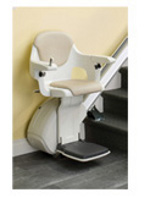Understanding Why and How to Use a Stair Chair
Published by Stephen on June 2, 2010 Under stair lifts For those seniors who live in a home with stairs, the risk for a serious fall and injury is greatly increased. These types of injuries can be very serious, often including broken hips or bones, and are also much harder to recover from for the elderly.
For those seniors who live in a home with stairs, the risk for a serious fall and injury is greatly increased. These types of injuries can be very serious, often including broken hips or bones, and are also much harder to recover from for the elderly.
Often, the inability to safely use the stairs is a leading motivator when a senior moves to a retirement community, as most assisted living facilities allow their residents full access to the facility, without having to use the stairs. However, since moving to a retirement home represents such a major lifestyle change, let alone monthly cost, many opt to remain in their home, while finding a way to use the stairs safely.
One of the most common ways of allowing a senior, or other individual with limited mobility, to use the stairs is by installing a stair lift. Stair lifts, often referred to as stair chairs, are almost like having a personal escalator installed on your stairway and are designed to carry an individual safely along their staircase. However, where a personal escalator would require a major renovation to the home, a stair lift can be installed with standard tools by most experienced Do-It-Yourselfers. Of course, even if you were to opt for a professional stair chair installation, it would still be much less expensive than installing an escalator, or for that matter an elevator.
Stair lifts work by moving slowly along a metal track and are powered by an electric motor. Depending on the type of stair lift, it may run off of rechargeable batteries or directly from the household power. Battery Powered Stair Chairs are more expensive than AC Stair Chairs, but they offer an uninterruptible power supply. This means that even a storm were to knock out power to the home, the battery powered stair lift could still be used, although these types of stair chairs are more expensive than other models.
The chair of the stair lift, which is where they get the name stair chair, provides a safe place for the user to sit as they are carried up the staircase. Most offer a folding seat, which helps reduce the amount of room the unit takes up when not in use, as well as many stair lifts that offer extra padding.
The Stair Lift’s seat is attached to a metal track that spans the length of the staircase. It is usually made out of lightweight aluminum, which is very strong. The metal track is attached to the steps of the staircase and the motor either uses a geared system to crawl up a geared track or uses a cable pull system.
Controlling the stair chair is done with a simple hand control that is either attached to the armrest of the seat or wired to a simple hand control. Multiple wireless controllers are also provided, which can act as call units for the top and bottom of the stairs. As a safety feature, the stair lift will only move while the button is being pressed. The constant pressure switch ensures that accidentally brushing up against the stair lift controls will not start it moving. Most also include a collision detection sensor in the footrest, which stops the stair lift if it encounters something on the stairway.
Using a stair chair is a great way to help make the stairs easier to use, without sacrificing independence or functionality, as even with a stair chair installed, it is still possible to regularly use the stairway. These types of home medical equipment also provide a cost effective alternative to moving or installing an elevator.
No Comments |
Add a Comment